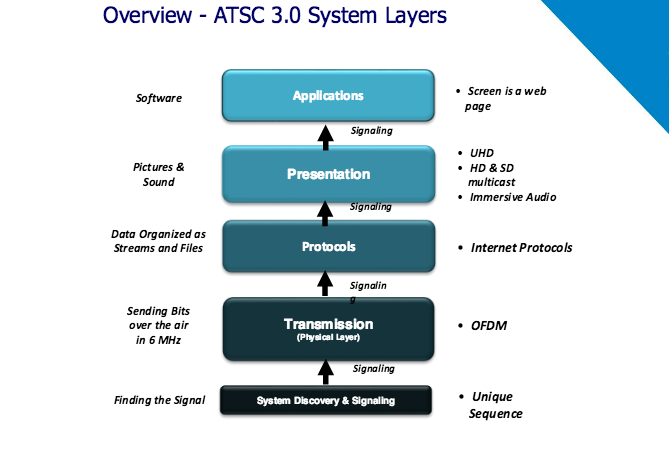First Element of ATSC 3.0 Approved for Standard

WASHINGTON—The Advanced Television Systems Committee has approved the bootstrap component of its developing broadcast transmission standard. “Bootstrap” refers to the “System Discovery and Signaling” architecture of the ATSC 3.0 physical layer. The bootstrap provides a “universal entry point into a broadcast waveform,” for multiple service types such fixed and mobile television, for example.
It is the first element of ATSC 3.0 to reach standard status. This means there will be no further modifications made to this particular element of the developing ATSC 3.0 standard. The bootstrap signal is one of the five technologies that will comprise the physical layer, the foundation of the standard. The remaining four are at “Candidate Standard” status and await a full vote.
The bootstrap architecture is “integral to reception,” according to TV Technology contributor Doug Lung. “The receiver only has to detect the bootstrap signal to know there is a DTV signal on a channel. The bootstrap signal is much more robust than the payload data, so antenna positioning isn’t likely to be a problem.” (See “The ATSC 3.0 Physical Layer—Bootstrap Basics.” Dec. 23, 2015.)
The bootstrap signal uses a fixed configuration “known to all receiver devices,” the bootstrap standard document states. Another characteristic provided by the bootstrap architecture is the accommodation of future signal configurations, including those not directly associated with the ATSC 3.0 standard:
“New signal types, at least some of which have likely not yet even been conceived, could also be provided by a broadcaster and identified within a transmitted waveform through the use of a bootstrap signal associated with each particular time-multiplexed signal. Some future signal types indicated by a particular bootstrap signal may even be outside the scope of the ATSC.”
The remaining components of the physical layer at Candidate Standard status include the “Physical Layer Protocol,” which describes the RF transmission system of the waveform. The CS period ends for the PLP April 4. “Signaling, Delivery, Synchronization and Error Protection” defines the “technical mechanisms and procedures pertaining to service signaling and IP-based delivery of a variety of ATSC 3.0 services and contents” over-the-air, via broadband and a hybrid of the two. It will come up for a vote after the CS period ends July 31.
All ATSC 3.0 Candidate Standards are available here.
For a comprehensive list of TV Technology’s ATSC 3.0 coverage, seeour ATSC3 silo.
See more of Doug Lung’s contributions, including...
November 3, 2015
“Getting Ready for the Repack”
After the FCC incentive auction is complete, likely before we transition to ATSC 3.0, many UHF TV stations will have to move to new channels. Many TV translator stations will have to find new channels, if they can.
July 23, 2015
“Getting Ready for ATSC 3.0”
The amount of spectrum devoted to TV broadcasters is shrinking—from a peak of 486 MHz before 1983 to 294 MHz today.
Also see…
May 7, 2015,
“ATSC 3.0 Bootstrap Signal Becomes Candidate Standard”
The first of five components in the Physical Layer transmission standard for ATSC 3.0 has been elevated to “Candidate Standard” status.
Get the TV Tech Newsletter
The professional video industry's #1 source for news, trends and product and tech information. Sign up below.
